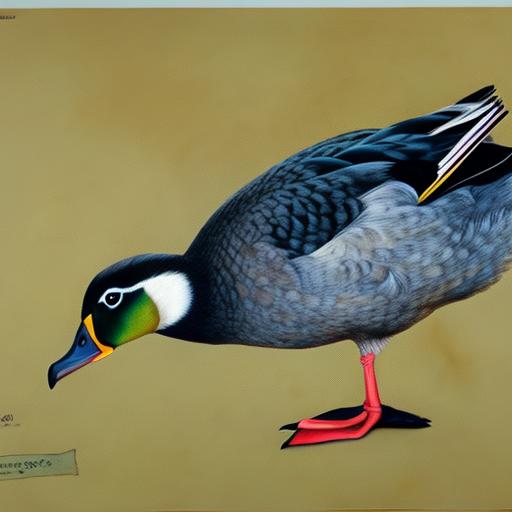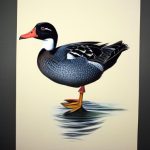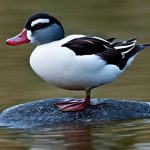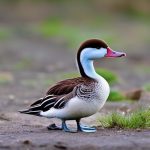Black ducks, scientifically known as Anas rubripes, are a species of dabbling duck found in North America. They are medium-sized waterfowl with a distinctive dark plumage that gives them their name. Black ducks are known for their adaptability and can be found in a variety of wetland habitats, including marshes, ponds, and rivers. They are also known for their unique quacking sound, which sets them apart from other duck species. Black ducks are an important part of the ecosystem, playing a crucial role in maintaining the balance of wetland habitats and serving as a food source for various predators.
Black ducks are a popular game bird among hunters due to their elusive nature and challenging behavior. They are also a common sight for birdwatchers and nature enthusiasts, who appreciate their beauty and unique characteristics. In recent years, black ducks have faced threats to their population due to habitat loss and hunting pressure, making conservation efforts crucial to their survival. Understanding the physical characteristics, habitat, behavior, and conservation status of black ducks is essential for ensuring their continued existence in the wild.
Key Takeaways
- Black ducks are a species of waterfowl found in North America, known for their dark plumage and distinctive quacking sound.
- They have a mottled brown body, with a darker head and tail, and a bright yellow bill.
- Black ducks prefer freshwater habitats such as marshes, ponds, and streams, and can be found across the eastern United States and parts of Canada.
- They are omnivorous, feeding on a variety of aquatic plants, insects, and small fish.
- Black ducks are monogamous and build their nests in dense vegetation near water, laying around 8-10 eggs per clutch. Their conservation status is of Least Concern, but they face threats from habitat loss and hunting.
Physical Characteristics of Black Ducks
Black ducks are medium-sized waterfowl with a length of about 20-22 inches and a wingspan of 30-35 inches. They have a dark brown to black plumage with a lighter mottled appearance on their body, giving them a distinctive look. Their bill is yellowish-orange with a dark spot at the base, and their legs and feet are also orange. The male and female black ducks have similar plumage, making it difficult to distinguish between the sexes based on appearance alone.
In terms of behavior, black ducks are known for their strong flight capabilities and agile swimming skills. They have a unique quacking sound that sets them apart from other duck species, making them easily recognizable in the wild. Black ducks are also known for their adaptability to various wetland habitats, allowing them to thrive in different environments. Their diet consists of aquatic plants, seeds, insects, and small invertebrates, which they forage for in shallow water or on land.
Habitat and Distribution of Black Ducks
Black ducks can be found in a wide range of wetland habitats across North America, including freshwater marshes, ponds, rivers, and coastal estuaries. They prefer areas with dense vegetation for nesting and feeding, as well as open water for swimming and foraging. Black ducks are known for their adaptability to different environments, allowing them to thrive in both natural and human-altered landscapes.
Their distribution ranges from the eastern United States and Canada to parts of the Midwest and Atlantic coast. They are also found in parts of the Great Lakes region and the Canadian Maritimes. Black ducks are migratory birds, with some populations traveling south to wintering grounds in the southern United States and Mexico. Their ability to migrate long distances allows them to access different habitats throughout the year, ensuring their survival in changing environmental conditions.
Behavior and Diet of Black Ducks
Black ducks are primarily dabbling ducks, meaning they feed by tipping forward in the water to reach aquatic plants, seeds, and small invertebrates. They also forage on land for grasses, grains, and insects. Their diet is diverse and varies based on the availability of food in their habitat. Black ducks are known for their social behavior and can often be found in small flocks during feeding and resting periods.
During the breeding season, black ducks form monogamous pairs and build nests in dense vegetation near water. The female lays a clutch of 8-10 eggs, which she incubates for about 25-30 days before hatching. The ducklings are precocial, meaning they are born with their eyes open and are able to leave the nest shortly after hatching. The parents provide care and protection for the ducklings until they are old enough to fend for themselves.
Breeding and Reproduction of Black Ducks
Black ducks typically breed in the spring and early summer, with nesting sites located near water in dense vegetation such as cattails or reeds. The female constructs the nest using grasses and other plant materials, creating a shallow depression lined with down feathers for insulation. She lays a clutch of 8-10 eggs, which she incubates for about 25-30 days before hatching.
Once the ducklings hatch, they are precocial and able to leave the nest within hours. The parents lead them to water where they can forage for food and learn essential survival skills. The ducklings grow quickly and are able to fly within 50-60 days after hatching. Black ducks exhibit strong parental care, with both the male and female taking an active role in protecting and raising their offspring.
Conservation Status of Black Ducks
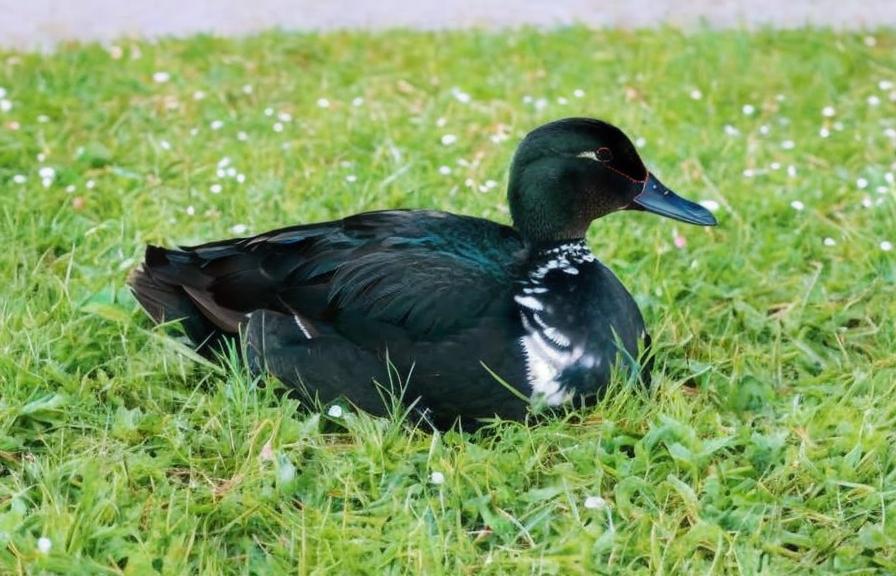
The conservation status of black ducks is a topic of concern due to declining populations in recent decades. Habitat loss, hunting pressure, and competition with other duck species have all contributed to the decline of black duck populations. Conservation efforts have focused on protecting wetland habitats, implementing hunting regulations, and monitoring population trends to ensure the long-term survival of black ducks.
Several organizations and government agencies have been involved in conservation initiatives aimed at preserving black duck populations and their habitats. These efforts include habitat restoration projects, research on migration patterns, and public education programs to raise awareness about the importance of wetland conservation. By addressing the threats facing black ducks and implementing sustainable management practices, it is possible to reverse the decline of their populations and ensure their continued existence in the wild.
Popular Black Duck Breeds for Domestication
Black ducks are also popular among poultry enthusiasts for domestication due to their unique characteristics and adaptability to different environments. Several breeds of black ducks have been developed for domestication, each with its own distinct traits and qualities. Some popular black duck breeds include the Cayuga duck, East Indies duck, and Swedish black duck.
The Cayuga duck is known for its iridescent green-black plumage that shimmers in the sunlight. They are prized for their calm temperament and excellent egg-laying abilities, making them a popular choice for backyard poultry keepers. The East Indies duck is a smaller breed with a striking black plumage that makes them stand out in any flock. They are known for their friendly disposition and adaptability to various climates, making them a versatile choice for domestication.
The Swedish black duck is another popular breed known for its solid black plumage and hardy nature. They are excellent foragers and can thrive in free-range environments, making them well-suited for sustainable farming practices. These black duck breeds offer poultry enthusiasts a unique opportunity to raise and care for these beautiful birds while contributing to the preservation of their genetic diversity.
In conclusion, black ducks are an important species of waterfowl with unique physical characteristics, behaviors, and habitat requirements. Understanding their role in the ecosystem and the threats they face is essential for implementing effective conservation measures. By preserving wetland habitats and supporting sustainable management practices, it is possible to ensure the continued existence of black ducks in the wild while also enjoying their beauty through domestication.
If you’re interested in learning more about breeds of black ducks, you might also want to check out this informative article on how to care for goslings. Understanding the care and maintenance of waterfowl can provide valuable insights into the world of duck breeds and their specific needs.
FAQs
What are the different breeds of black ducks?
There are several breeds of black ducks, including the American Black Duck, the East Asian Black Duck, and the Pacific Black Duck.
What are the characteristics of black ducks?
Black ducks are medium-sized ducks with dark plumage, often with a glossy green or purple sheen. They have a slightly lighter coloration on their underparts and a distinctive yellow or orange bill.
Where are black ducks commonly found?
Black ducks are found in various regions around the world, including North America, East Asia, and Australia. They prefer freshwater habitats such as marshes, ponds, and rivers.
What do black ducks eat?
Black ducks are omnivorous and feed on a variety of foods, including aquatic plants, insects, small fish, and crustaceans.
Are black ducks endangered?
The American Black Duck is considered a species of least concern, but populations have declined in some areas due to habitat loss and hunting. The East Asian Black Duck and Pacific Black Duck are also not currently considered endangered.
Meet Walter, the feathered-friend fanatic of Florida! Nestled in the sunshine state, Walter struts through life with his feathered companions, clucking his way to happiness. With a coop that’s fancier than a five-star hotel, he’s the Don Juan of the chicken world. When he’s not teaching his hens to do the cha-cha, you’ll find him in a heated debate with his prized rooster, Sir Clucks-a-Lot. Walter’s poultry passion is no yolk; he’s the sunny-side-up guy you never knew you needed in your flock of friends!

